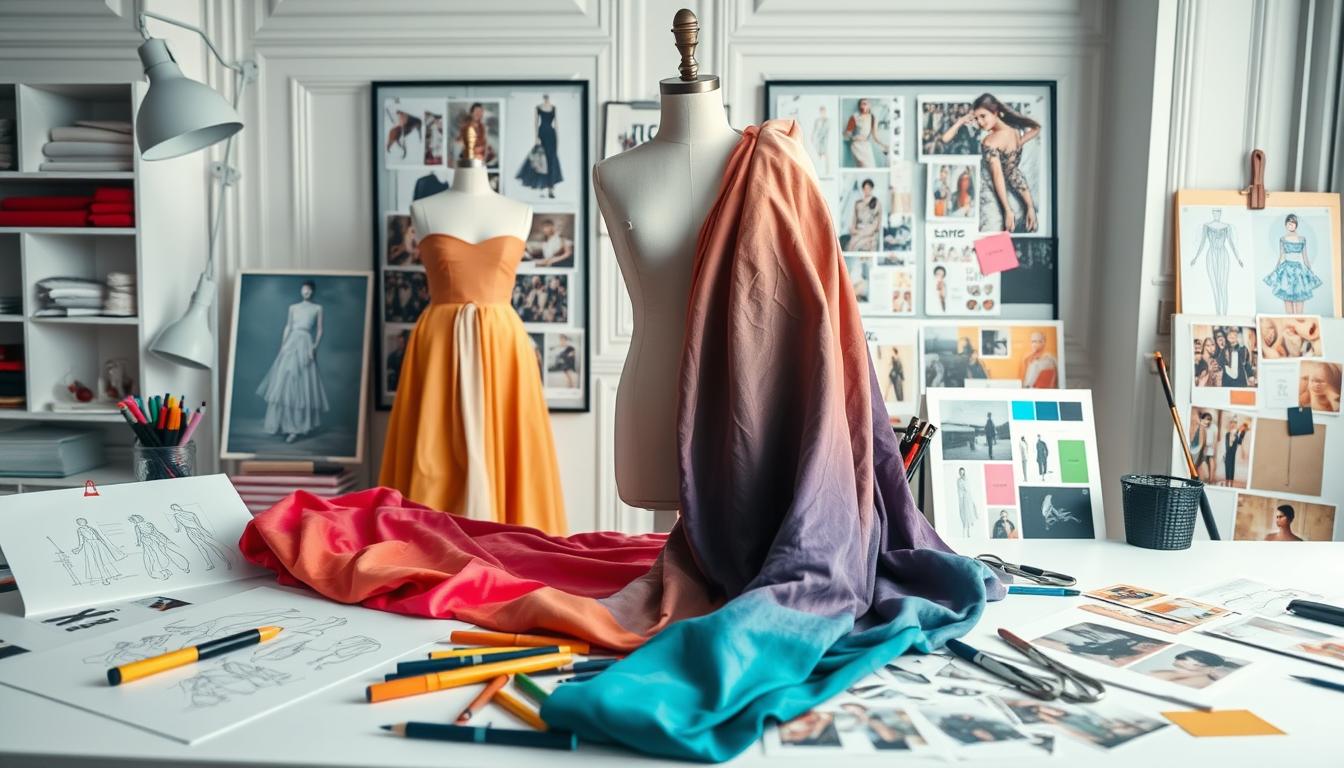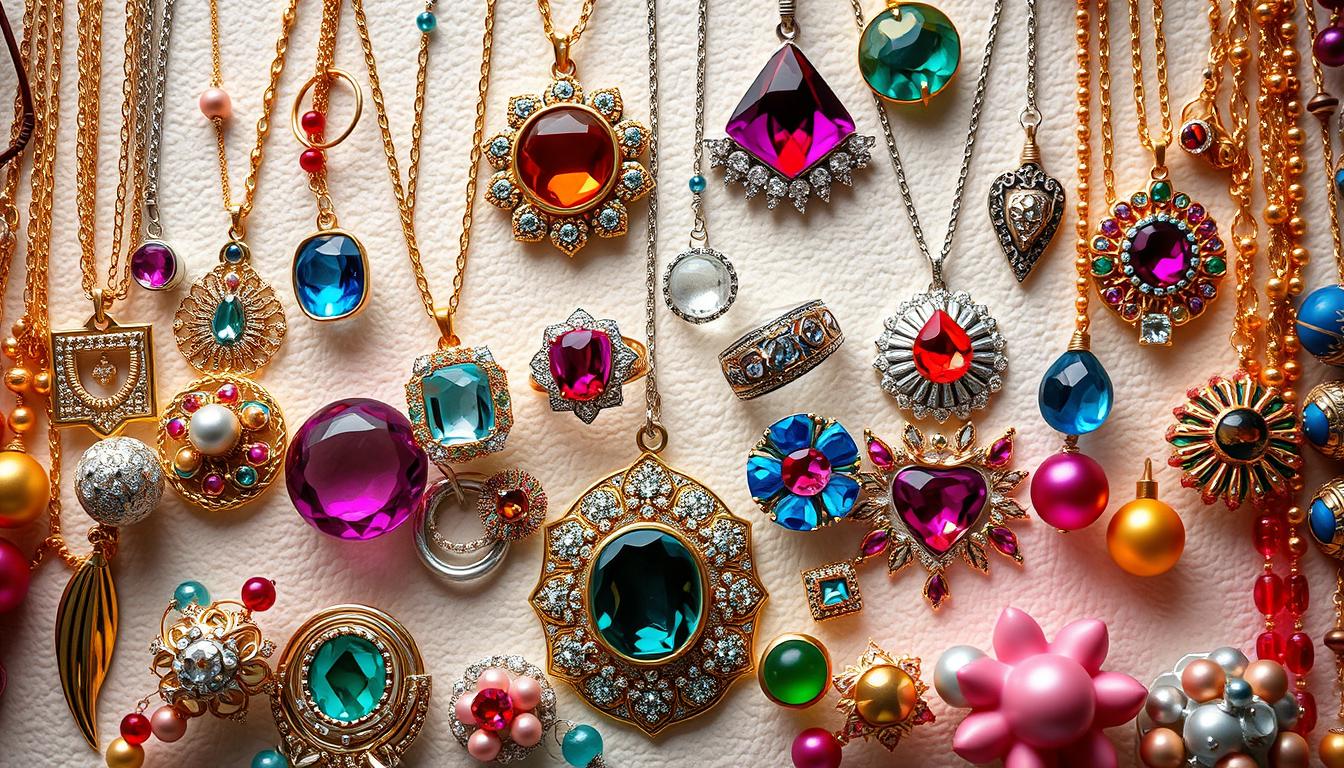In the world of fashion design, a great portfolio is key. It shows off your creativity, skills, and unique style. Designers like Alexis Walsh, Aline Pérot, and Sarah Park are changing the game with their bold designs.
Whether you focus on abstract ideas or practical clothes, your portfolio must share your vision. It should show your design philosophy, technical skills, and love for fashion.
Digital portfolios have opened new doors for designers. They let you show your work in creative ways. With tools like tiled galleries and horizontal scrolling, you can make a strong impression online.
By using the latest digital tools, you can grab the attention of industry pros and clients. This sets you apart in the competitive world of fashion.
Key Takeaways
- Fashion portfolios are crucial for showcasing your design work and connecting with industry professionals.
- Portfolios can be physical or virtual, ranging from abstract to functional designs.
- Online portfolios offer various presentation styles, from tiled galleries to horizontal scrolling experiences.
- Designers are pushing boundaries with innovative approaches, including 3D printing and upcycling.
- Effective portfolios communicate your design philosophy, technical expertise, and passion for fashion.
Understanding the Importance of a Fashion Design Portfolio
In the fast-paced world of fashion design, a great portfolio is key. It’s a showcase of your best work, highlighting your skills and creativity. It’s a visual way to share your talent and style with the world.
What is a Fashion Portfolio?
There are two main types of fashion design portfolios. A Personal Portfolio shows your skills and experience. A Specific Portfolio is made for a specific client or job, focusing on work that fits their needs.
The Role of a Portfolio in Your Career
A fashion design portfolio is crucial for finding jobs and attracting clients. It helps you stand out in a competitive market. A well-made portfolio can lead to more interviews and job offers.
Key Elements of an Effective Portfolio
A good portfolio includes an introduction, concept mood boards, technical drawings, and photos of your designs. Concept boards are important for presenting your ideas. They should be simple and clear to share your vision.
Also, include digital fashion flats, technical sketches, and photos of your finished garments. This shows your technical skills and attention to detail.
By organizing and presenting your work well, you can share your unique design aesthetic. This can help you succeed in the fashion industry.
Choosing the Right Format for Your Portfolio
In the world of fashion design, your portfolio’s format is key. It affects how you show your work to employers or clients. With digital advancements, choosing between a digital or physical portfolio is crucial.
Digital vs. Physical Portfolios
Digital portfolios are now more popular. They let designers show their work easily and in many ways. Online portfolios are easy to update and share, reaching more people. Yet, physical portfolios can still impress in meetings and interviews.
Online Portfolios: Pros and Cons
- Increased accessibility and visibility through online platforms
- Ability to regularly update and refine your work samples
- Cost-effective compared to printing and maintaining a physical portfolio
- Potential for interactive features and multimedia presentations
- Concerns about digital security and the longevity of online platforms
- Potential for decreased personal connection with the audience
Essential Tools for Creating a Digital Portfolio
For a fashion portfolio online, tools like Pixpa are great. They have templates made for fashion designers. These platforms make it easy to show your fashion design portfolio templates well.
| Tool | Key Features |
|---|---|
| Pixpa | Customizable templates, online portfolio hosting, e-commerce integration |
| Adobe Creative Cloud | Industry-leading design software for creating digital portfolio assets |
| Squarespace | All-in-one website builder with portfolio-friendly templates |
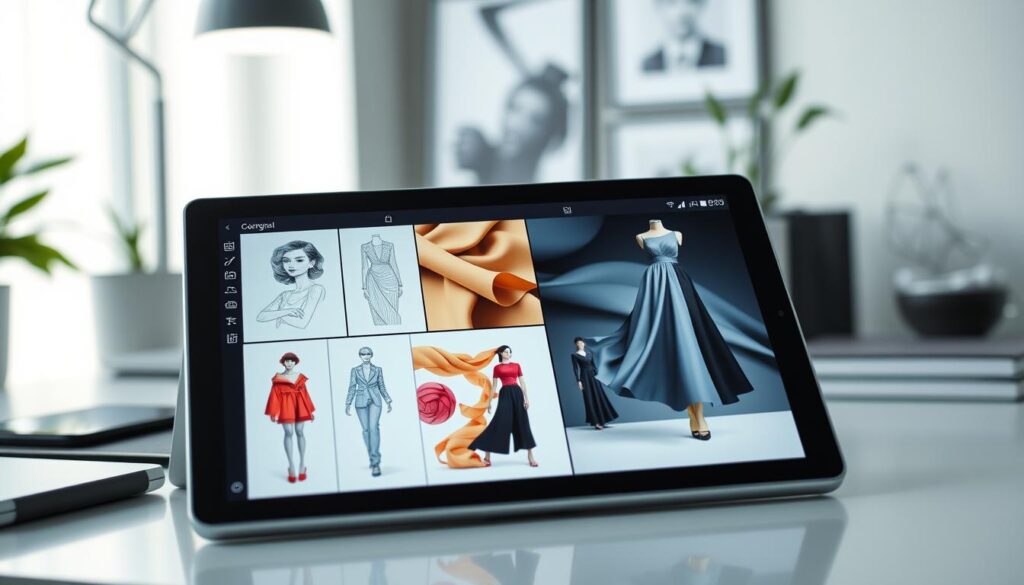
When picking between digital and physical, think about your audience and job goals. Digital portfolios are flexible, but physical ones impress in person. Choose what fits your career and what employers like.
Showcasing Your Best Work
Creating a great fashion design portfolio means picking your most recent and highest-quality work. Focus on quality, not quantity. Choose 2-3 projects that show your unique design aesthetic and technical skills. Make sure your portfolio fits the job or industry you’re aiming for.
Include high-quality images of your final collections, styled garments, and mood boards. Mix hand-drawn silhouettes with digital designs to show your range. Keep your portfolio’s visual style consistent to build a strong brand.
Presentation Tips for Your Work
When showing your designs, focus on the layout and organization of your portfolio. Use clean, professional templates and clear, well-lit photos to make your work stand out. Add extras like fabric swatches, sketches, or mock-ups to give a hands-on feel and show your design process.
Incorporating Different Styles and Techniques
- Show a variety of design styles and techniques to prove your versatility and adaptability.
- Include both digital and hand-drawn elements, like technical flats, illustrations, and detailed tech packs.
- Highlight your skills in different areas, from apparel and accessories to textiles and prints.
- Show you’re skilled in industry-standard software like Adobe Illustrator and InDesign.
By carefully selecting and presenting your best fashion portfolio presentation, you’ll grab the attention of potential employers or clients. You’ll show off your top fashion design skills.
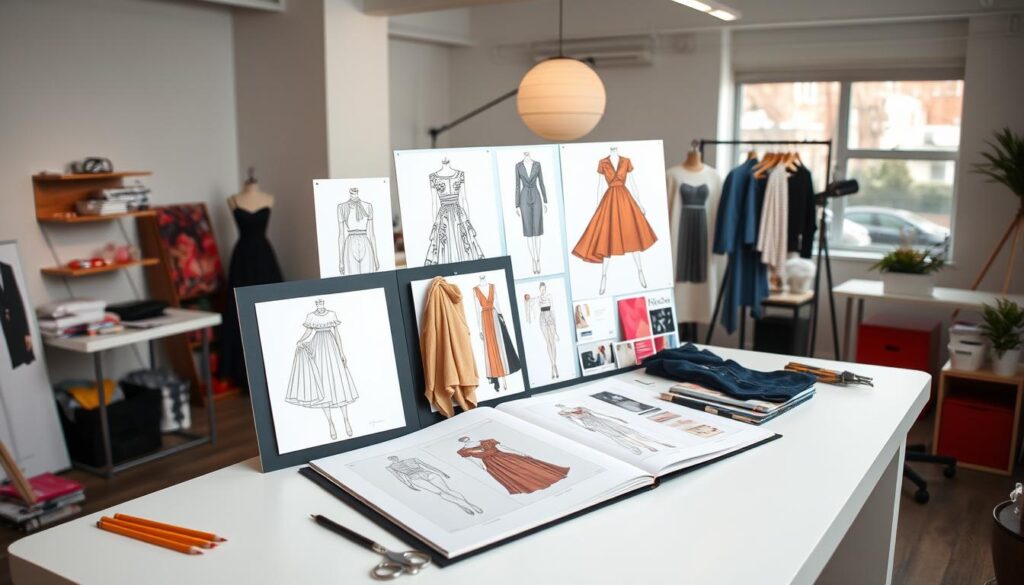
Telling Your Design Story
Creating your fashion design portfolio is more than just showing off your skills. It’s about telling a story that shows who you are as a designer. Your portfolio should open a window into your design philosophy, what inspires you, and how your style has grown.
Crafting a Compelling Narrative
Start by thinking about the story you want to tell. What themes, ideas, or personal experiences have shaped your designs? Turn these into a story that takes the viewer through your creative journey. Share the “why” behind your designs, not just the “what”.
The Importance of Inspiration Boards
Inspiration boards are key to showing what drives your designs. Set aside a few pages to show the images, textures, and colors that inspire you. This gives context and shows the thought behind your work.
Highlighting Your Journey and Growth
Fashion design is always changing, and your portfolio should show your growth. Include pieces from different times in your career. This shows how you’ve improved and inspires confidence in your future.
By telling a compelling story, using inspiration boards, and showing your growth, you’ll make a portfolio that really stands out. Remember, your portfolio is a reflection of your unique design identity.
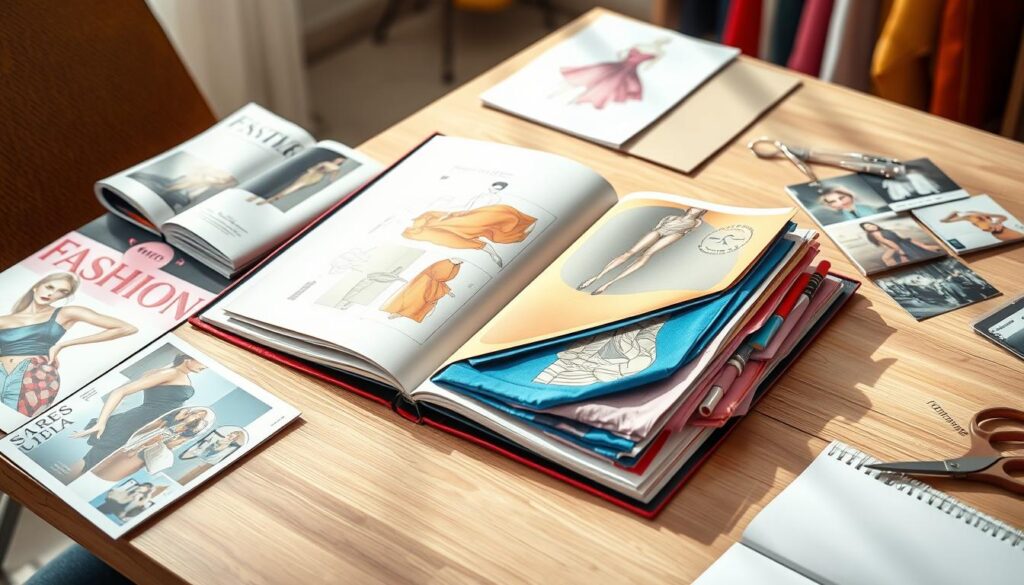
Incorporating Sketches and Illustrations
In the world of fashion design, sketches and illustrations are vital. They show your artistic skills and problem-solving abilities. When making your fashion design portfolio, choose sketches and illustrations that truly show your work’s essence.
Why Sketches Matter in Fashion Design
Sketches are the base of fashion designs. They show your skill in turning ideas into real designs. They let others see how your designs grow from the start to the final product.
Techniques for Effective Illustration
Being versatile is key in fashion illustration. Mix hand-drawn and digital illustrations to show your skills. For luxury brands, hand-drawn sketches are powerful, showing artistry and detail.
Try different mediums like pencils, charcoal, and watercolors. Find what works best for you and your designs.
Showcasing Process Over Product
Instead of just showing your final designs, show your design process. Include early sketches, changes, and how your ideas grew. This shows your problem-solving and creative thinking.
Highlighting your design journey gives a deeper look into your creative process. It shows the thought behind your work.
Remember, the quality and how you present your sketches and illustrations matter a lot. Make sure they are clear, high-quality, and grab attention. By focusing on these key elements, your fashion design portfolio will stand out and show off your unique talents.
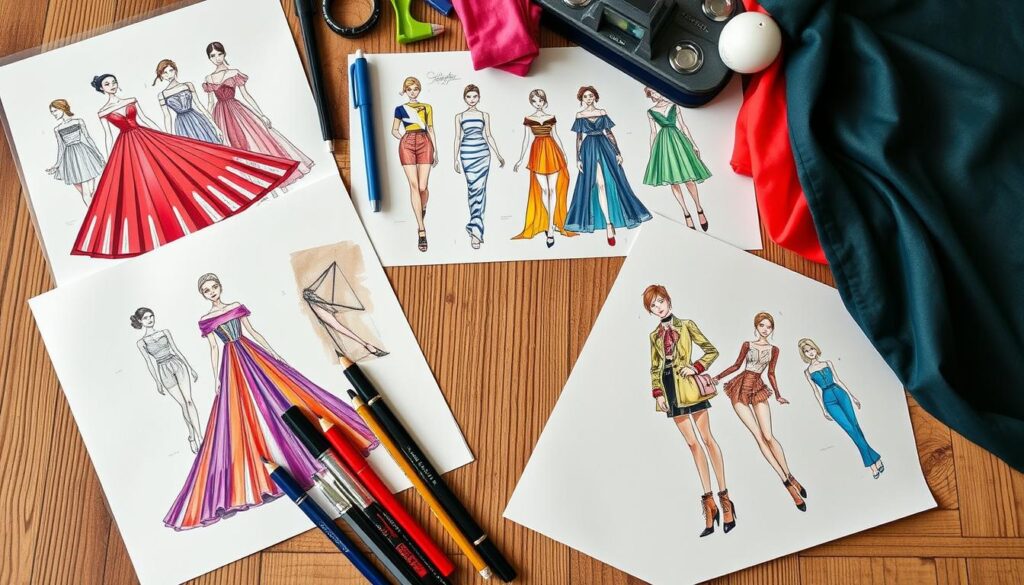
Using Mood Boards Effectively
Mood boards are a key tool in fashion design. They help share brand ideas and inspiration. These visual aids mix images, fabrics, colors, and textures to show a designer’s vision.
What is a Mood Board?
Old-school mood boards were made from magazine cutouts and fabric samples on foam boards. Now, they can be digital, using tools to create a unified look.
How to Create an Engaging Mood Board
- Start by researching for inspiration from art, architecture, and nature.
- Choose images, textures, and colors that match your brand and design.
- Arrange these elements in a way that clearly shows your vision.
- Include notes to explain the importance of each part of the mood board.
Examples of Inspirational Mood Boards
Here are 20 mood boards that show different styles and themes:
| Mood Board Theme | Design Elements | Inspirational Sources |
|---|---|---|
| Dark Green Elegance | Lace, pleats, pearls | Victorian Regency era |
| Vibrant Celebration | Bright colors, flowers, bows | 2024 Paris Olympics |
| Timeless Greenery | Foliage, neutrals, minimalism | Nature |
These examples show mood boards can capture many styles, from bold to elegant. They help designers and marketers share their ideas and stay true to their brand.
Including Client Work and Collaborations
When building your fashion portfolio, it’s key to show your original designs and your teamwork skills. Highlighting client projects and team efforts shows you’re adaptable and communicative. These skills are crucial in the fashion world.
Presenting Collaborative Projects
If you’ve worked on team projects, make sure to include them in your portfolio. Explain your role and what you contributed. This way, you show you can work well with others, a vital skill in fashion.
Leveraging Client Testimonials
Adding client testimonials to your portfolio can boost your credibility. Ask past clients for a brief statement about working with you. Their feedback can prove your professionalism and the quality of your work.
Highlighting Team Efforts
When showing team projects, balance your individual work with the team’s effort. This shows you can work well in a team and highlights your skills.
| Key Insights | Data Point |
|---|---|
| Number of views | 841 |
| Percentage increase in landing clients with a well-made portfolio | Not provided |
| Percentage increase in revenue when a job is obtained through portfolio presentation | Not provided |
| Average number of elements in a fashion photography portfolio | 7 |
| Percentage of photographers who include a photography price list in their portfolio | Not provided |
By including client work and team projects in your portfolio, you show your versatility and teamwork skills. These are key to standing out in the competitive fashion design world.
Adding a Resume and Bio
As a fashion designer, your portfolio is a powerful tool. It shows your creativity and expertise. But, remember, your portfolio is just part of the picture. Your resume and bio are also key to showing your professional side.
Key Information to Include in Your Bio
Your fashion design bio should be short and engaging. It should be no more than seven lines. Focus on your design philosophy, career highlights, and any notable collaborations or clients.
This brief introduction will give a glimpse into your design identity. It shows what makes you unique.
Writing an Engaging Fashion Resume
When writing your fashion resume, make it specific to the industry. Highlight your relevant skills, education, and experience. Show off your most notable projects and achievements.
Include any big-name clients or brands you’ve worked with. This shows your credibility and expertise. Keep your resume’s style and tone consistent with your portfolio for a professional look.
How Your Resume Complements Your Portfolio
Your resume and portfolio work together to show your skills as a fashion designer. Your portfolio showcases your visual design and creative process. Your resume, on the other hand, highlights your supporting skills, education, and experience.
By aligning these two, you create a complete picture of your design journey and qualifications. This gives the viewer a deeper understanding of your abilities.
“A strong fashion design portfolio, combined with a professional resume and bio, is the key to standing out in a competitive industry.”
Exploring Different Themes and Concepts
Creating a standout fashion design portfolio means exploring various themes and concepts. This shows your versatility and unique style. By focusing on specific ideas, you can share your creative vision and grab your audience’s attention.
Thematic Portfolio Ideas
Think about themes that match your design philosophy and message. Some great ideas include:
- Sustainability: Show your eco-friendly side with upcycled designs or sustainable materials.
- Cultural Influences: Use your heritage or global cultures to celebrate diversity in your portfolio.
- Innovative Materials: Try out unusual materials like recycled plastics to show your versatility.
Balancing Themes and Personal Style
While exploring themes, keep your personal style in mind. Make sure your portfolio balances the theme with your unique style. This creates a cohesive and memorable presentation that shows your individuality.
Showcasing Collections or Series
Organize your designs into collections or series. They can share a theme, color palette, or inspiration. This shows you can develop and execute a design concept well. Use consistent lighting and styling for a professional and striking portfolio.
“A fashion portfolio should be a visually engaging and cohesive representation of your design journey, showcasing your creativity, technical skills, and personal style.”
Utilizing Photography to Enhance Your Portfolio
High-quality photography is key when showing off your fashion design work. You can either hire a professional or learn to take great photos yourself. Paying attention to lighting, angles, and styling can make your portfolio shine.
Importance of Quality Photography
In the fashion world, pictures are everything. Great photos can make your designs come alive and show off your skills. Quality photos show you care about how your work is presented.
Tips for Styling and Taking Photos
- Style your garments on models or mannequins to showcase how they look when worn.
- Avoid using photos of mannequins alone, as they can appear unprofessional.
- Experiment with different poses, angles, and backgrounds to create a visually engaging portfolio.
- Maintain consistent styling and photography techniques throughout your portfolio for a cohesive look.
Consideration of Lighting and Angles
Lighting and angles are crucial for great fashion photos. Try out different lighting setups to find the best look. Notice how the light affects the fabric and textures of your designs.
| Frequency of Creative Shoots | Collaboration Frequency with Hair and Makeup Artists | Continuous Learning and Improvement |
|---|---|---|
| The recommendation is to plan 1 or 2 creative shoots for a fashion portfolio each month. | Once 1 or 2 shoots are completed for the portfolio, photographers are advised to reach out to local hair and makeup artists for collaboration on future shoot ideas. | Emphasizes the need to keep shooting and learning, indicating that photographers will learn more while shooting than through passive learning methods like reading or watching videos. |
By focusing on quality photography and styling, you can make your fashion portfolio stand out. Remember, how you present your work is just as important as the designs themselves.
Keeping Your Portfolio Updated
Building a fashion design portfolio is an ongoing task. It’s key to keep it fresh with your latest work. As you grow, update your portfolio often, removing old pieces that don’t show your current skills. Try to update it at least once a year or after big new projects.
The Importance of Continuous Improvement
Fashion design keeps changing, and you must keep up. Improve your skills and try new things like digital fabric design or 3D printing. Staying current with trends will make your portfolio shine.
Seeking Feedback to Enhance Your Portfolio
Getting feedback from experts, mentors, or friends is very helpful. Use it to make your work better and show you can grow. A portfolio that changes shows you’re dedicated to your craft and ready for new challenges.

